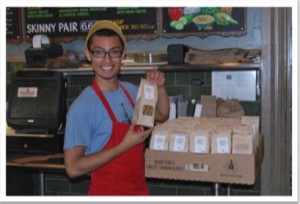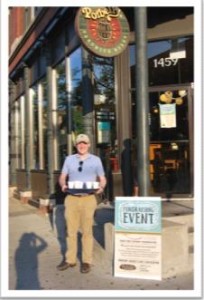The assigned objective was to create, plan and execute a fund raising project for a designated charity. Our team chose to support the Face The Future Foundation (FTFF). FTFF is a non-profit organization supporting the University of Illinois Craniofacial Center. The Craniofacial Center is one of the oldest and largest facilities in the world dedicated to the treatment of infants, children, adolescents and adults with cleft lip and palate and other congenital craniofacial conditions.
Our team partnered with Potbelly Sandwich Works, specifically the store located at 1459 W. Taylor Street. This location is steps away from the UIC campus and the Craniofacial Center. Potbelly pledged to donate 25% of sales during one evening’s dinner service (5-8pm). The event was held on Thursday, August 2. Our team recruited friends, FTFF board members and Craniofacial Center staff to attend the event. Team members offered free shakes to entice people on the street to attend the event and learn more about FTFF.
Our team chose to partner with these organizations because of existing relationships. Kacie is a member of the FTFF junior board. Kacie’s relationship facilitated faster and more effective communication with FTFF. Dan works for Potbelly in the marketing department. Dan leveraged Potbelly’s promotional resources and communicated with store leadership.
In addition to holding the Potbelly event, our team sought to leverage our personal and professional networks to raise funds. Team members used word-of-mouth, email and social media to drive people to the FTFF website to donate. Several team members sold Potbelly cookies to co-workers, family and friends. One team member held a company-sponsored “Wear Your Jeans to Work Day” to raise funds.
Our team raised $2,588.75, more than any other group in the class. Our team initially projected $200 as our fund-raising goal. However, that amount was solely revenue from Potbelly. After adding donations, we revised our goal to $1,000. We were able to far exceed our goal. We also were able to spread awareness of FTFF to hundreds of individual we touched in our campaign.
In our initial proposal, we estimated we would raise $212.50 through our partnership with Potbelly. Our actual total was $251.75, an 18% increase over the estimated total. It is clear that our event drove additional traffic to the Potbelly. We were able to bring more than 15 friends and co-workers to the event. Potbelly was very happy with our event, their first fund raiser.
Advice for future teams
Make sure you follow your plans and do not lose sight of your objectives. Our team did not use our implementation plan well enough. We each took our own assigned tasks and completed the tasks, but did not integrate our tasks into the larger project or interface with other team members enough. We would also recommend appointing a true project manager to facilitate collaboration and communication. Because of the size of our team, certain messages were not communicated uniformly or well enough. Irini blogged about the value of a communication plan – your team may benefit from that exercise.
Lessons Learned
Test everything! Be prepared for technology challenges! One challenge we faced was the FTFF website. The website was difficult to navigate for some users. This led to frustrated people not able to donate and a lot of last minute headaches for the team. This problem was not on our risk management plan and we did not anticipate this issue. In retrospect, our team should have thought this through as technology issues are common. We should have tested the website in advance.
Beware of scope creep. Given that our team had 7 members, we needed to raise a substantial amount of money for this project to be successful. Our team needed to raise funds beyond the $251.75 generated by Potbelly. However, as we added new branches to our fund raising plan (cookie sales, online donations, day-of cash donations, work sponsored event) it was difficult to manage everything. Our team lost sight of the initial objective to some degree and it was difficult to be on top of everything.
More is not always merrier. It was clear that this project could have been managed with fewer people. The extra people allowed our team to raise an impressive $2,588.75. However, the project could have been managed more effectively. Our team attempted to divide the project tasks evenly, but this was not possible and not efficient. Rather than have one person handle a task well, in some cases, we divided the task further and allocated the work to two people. The result was not cohesive.




